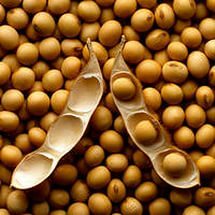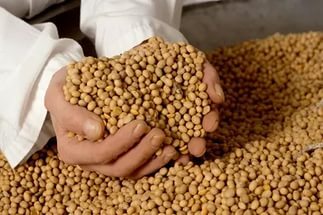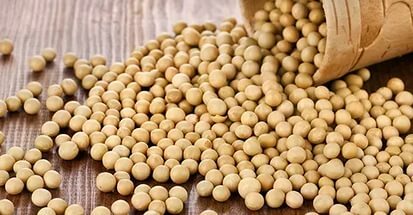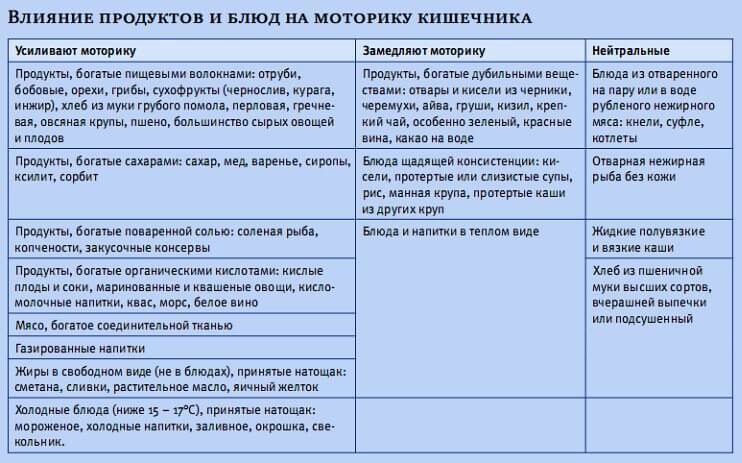Soybean: benefit and harm

Cultural soybeans belong to the family of leguminous plants.Today, it is well known and widespread throughout the world.Due to the unique chemical composition and high yield, soy is used in the production of many food products.
Contents:Growing soybean
The history of soybeans began in the third millennium BC, which means that this culture is one of the oldest on the planet.Soybean can be considered the birthplace of China, since it was in this country during the archaeological excavations that the rock paintings with its image were found, and the first written references also refer to China.
The next country that has cultivated soybean - Korea.Then, around 500 BC, it was eaten on the Japanese islands.Europe, this culture became known in the XVIII century, France became the "pioneer".The United States of America cultivated soybeans later - at the beginning of the 19th century, when a lot of plant samples were brought to the country with which the best breeding institutions worked.A little later, Americans began to grow soybeans on an industrial scale, and by the middle of the 20th century, it had planted about a million hectares of land.
 On the Russian lands, the first soybean crops were made in 1877, and the selection works began already in 1912, for which an experimental field at the mouth of the Amur River was provided.If you believe the experts, 1924-1927 became "sign" in the cultivation of soybeans in Russia.It was at that time that the fields of the Krasnodar and Stavropol Territories, as well as the Rostov Region, began to be sown in large numbers.
On the Russian lands, the first soybean crops were made in 1877, and the selection works began already in 1912, for which an experimental field at the mouth of the Amur River was provided.If you believe the experts, 1924-1927 became "sign" in the cultivation of soybeans in Russia.It was at that time that the fields of the Krasnodar and Stavropol Territories, as well as the Rostov Region, began to be sown in large numbers.
Interesting! The Russian name "soy" is borrowed from the Romance languages (soja), and the European forms of this word lead to the Japanese "soy: yu", which means - soy sauce.
biochemical composition of soy
Nutritional value of 100 g:
- Calories: 364 kcal
- Proteins: 34.9 g
- Fat: 17.3 grams
- Carbohydrates: 17.3 grams
Showfull list »
- Dietary fiber: 13.5 c
- Water: 12 c
- Mono- and disaccharides: 5.7 c
- Starch: 11.6 g
- Ash: 5 c
- saturated fatty acid: 2.5 g
- Unsaturated fatty acids: 14.35 g
Microelements:
- Calcium: 348 mg
- Magnesium: 226 mg
- Sodium: 6 mg
- Potassium 1607 mg
- Phosphorus: 603 mg
- Chlorine: 64 mg
- Sulfur: 244 mg
Vitamins:
- Vitamin PP: 2,2
- mg beta-carotene 0.07 mg
- Vitamin A( RE) 12 ug
- Vitamin B1( thiamine): 0.94 mg
- Vitamin B2( riboflavin) 0.22 mg Vitamin B5
- (Pantothenic): 1.75 mg
- Vitamin B6( pyridoxine): 0.85 mg
- Vitamin B9( folic): 200 μg
- Vitamin E( TE): 1.9 mg
- Vitamin H( biotin):60 mcg
- Vitamin PP( Niacinvy equivalent):
- 9.7 mg Choline 270 mg
Microelements:
- Iron: 9.7 mg
- Zinc 2.01 mg
- Iodine: 8.2 g
- Copper:
- 500 mg Manganese 2.8 mg
- Chromium 16 mcg
- Fluoro 120
- mcg Molybdenum 99 mcg
- Boron: 750 ug
- Silicon: 177 mg
- Cobalt: 31.2 g
- Aluminum: 700 μg
- Nickel: 304 μg
- Strontium: 67 μg
Proteins and fats
The main component of this product is bLocos.By the way, soy is one of the most high-protein crops, due to which it is the main substitute for meat products and is well absorbed.
Fatty elements of soybeans also have a beneficial effect on the body, the grains of the plant contain:
- palmitic acid,
- linoleic and linolenic acids,
- oleic acid.
The benefits of the above acids have long been proven. For example, linolenic acid is a plant variant of omega-3 acids, as it prevents the development of atherosclerosis and reduces the likelihood of the formation of cancerous tumors:
- The content of soybean phospholipids has a beneficial effect on liver function, and in people with diabetes reduces the needIn insulin.
- Tocopherols - substances that affect the general condition of the body, increase its protective properties, as well as positively acting on the male potency.
Carbohydrates
These elements are presented in soy beans and polysaccharides.Also in the composition there are stachychoses and raffinoses, which are food for bifidobacteria and reduce the risks of the disease with intestinal dysbiosis.
The presence of fiber in soybeans improves digestion, prevents constipation.Also, the product contains isoflavones( claynestine, genistin, glycitein), which have a beneficial effect on heart function, prevent the development of osteoporosis, and also maintain hormonal balance in women during menopause.
Vitamins, micro and macro elements
- Soya contains a significant amount of macro and microelements: potassium, calcium, phosphorus, sulfur, iron, boron, magnesium, manganese, iodine and others.
- Vitamin composition of soy is also wide: folic acid, beta-carotene, pyridoxine, thiamine, pantothenic acid, biotin, riboflavin, vitamins of group E and PP.
From all of the above, it can be concluded that soy is rich in all the necessary substances for the stable operation and health of the human body.
The use of soybeans
In addition to the above-mentioned useful properties of soybeans, the following can be distinguished:
- Products from soybean contribute to weight loss, "fat burner" is lecithin.
- Lowering cholesterol in the blood - this ability of soy is accepted by all scientists without exception.To achieve positive results, the amount of soy protein consumed per day should not be less than 25 grams.
- As already mentioned, soy isoflavones can prevent the formation of tumors, in particular - the development of breast cancer.
- As soy is almost as good as meat in its nutritional composition, it is indispensable for people suffering from allergies to animal proteins and lactose.
Harmful soybean
Despite many useful qualities, soybeans also have contraindications.
Important! Children under 12 years are not recommended to consume soy in large quantities, as this can cause inhibition in the development of the endocrine system, resulting in problems with the functioning of the thyroid gland.
-
 Adults suffering from or suffering from endocrine system diseases are also not recommended to use this product, since a relapse can be caused.
Adults suffering from or suffering from endocrine system diseases are also not recommended to use this product, since a relapse can be caused. - Some researchers argue that soy products inhibit puberty in boys, while girls, on the contrary, are stimulated.
- With insufficient weight, soy can only aggravate the situation.
Important! For women preparing for the birth of a child, soy is strictly contraindicated!This fact is due to the high content of hormone-like compounds.
Genetic modification of soybean
It is worth noting that soy is one of the few crops of agriculture that has been subjected to this day and is subjected to genetic changes.Today transgenic soy is a part of many products.According to the law, manufacturers are required to indicate information on the product labels indicating the presence of modified soy.
For the first time transgenic soybean was released in the US in the late 90s of the last century.This method of cultivation is quite attractive for farmers, due to its low cost and effectiveness in combating weeds.Today, this product is allowed to be imported to different countries around the world, but the cultivation of GM soy is not allowed anywhere. For example, in Russia, the sowing of fields with any GM crops is prohibited, although scientists have not proven that they harm the body.
Transgenic plant varieties are mandatory tested, including a safety survey for both humans and the environment.Currently, only one form of GM soy is supplied to the market, but research laboratories are developing and new varieties are being developed which, in the opinion of scientists, will be distinguished by improved agronomic and nutritional properties.
Is genetically modified soybean and other GM products dangerous?These questions in this video review are answered by the geneticists:
Soy products
Soy and soy products are widely distributed in Japanese and Chinese cuisine, and vegetarians also like to include it in the diet.Let's consider what products containing this culture are the most popular.
- Soybean oil - obtained by spinning soybean seeds, often used for frying.
- Milk is a beverage produced on the basis of seeds.
- Soy meat is a product made from non-fat soy flour.
- Miso, kochhujan, twengjan are varieties of soybean pastes, used as seasoning for various dishes.
- Tofu - soy cheese, which, depending on the production process, can differ in consistency.
Also made from soya are flour, which is used similarly to wheat and rye, and soy sauce is a liquid, distributed in our country as a seasoning for fish and meat dishes.
Vegetarian sausages, sausages, cutlets and hamburgers are also based on soy products.Basically, they are sold as semi-finished products.
Interesting! Cake obtained after seed treatment is used in agriculture.It is added to animal feed.
Using soy in cosmetology
Many cosmetic companies prepare skin and hair care products based on hydrolyzed soy proteins - partially destroyed proteins obtained from pre-fat-free soy flour.Such products have a moisturizing and restoring effect and help smooth out fine wrinkles, that is, they have a rejuvenating effect. Soy-based masks can be prepared at home:
- Grind a couple of handfuls of soy in a coffee grinder and pour boiling water, wait for the cooling, then add the egg yolk and about a tablespoon of olive oil.Apply on a clean face and hold for 10-15 minutes, then rinse with water and treat the skin with a moisturizer.
- This same mixture can be used for hair.To do this, you need to distribute it along the entire length, wrap your head with a towel and wait 50-60 minutes.Then wash off the mask with running water and wash the head with shampoo.
Afterword
It should be noted that the benefits and harms of this product have been written many times.The best world scientists are still arguing whether the soy is actually useful / harmful.There are many contradictions, and on some issues the researchers have not yet come to a common opinion.
Whether to use soya cooking for your family, it's up to you, but remember one simple rule - all is well in moderation!How many useful properties the product would not possess, it is not worth making a cult out of it.Eat a variety and watch for physical health - it certainly will not hurt!



